Back To The Roots Of Wine: A List Of Trios Showcase The Diversity Of France’s Wine Regions A Fresh Look Into What Makes The Country The Wine World’s North Star
The world is a galaxy of wine, and at its center lies a vinous, red-and-white hole of such density that all other wine regions tend to circle it, drawn by the gravity of its reputation and know-how. These other regions are not necessarily ‘pretenders’ and indeed, some of the students have at times transcended the master. They are satellites drawing energy from a mothership called France: Cabernet Sauvignon and Sauvignon Blanc, Pinot Noir and Chardonnay, all are benchmark varieties in nearly every pocket of the planet that can support them.
Through ups and downs, missteps and natural disasters, the immensity of this tug remains, and at Elie’s, it remains irresistible, even if it may be time to paint over the Mona Lisa.
France has always been its own best friend and worst enemy; a truism in times of war and peace. An epicenter for cuisine and fine wine, it has tended to rest on its laurels a bit too long, until reputation became a stand-in for quality. And then, waking up, in a desperate attempt at reinvention, it has occasionally strayed down rocky roads. Still, the French begin with an advantage denied nearly everyone else—spectacular terroir across the whole of its wine producing regions. Rebounding from the blunders of the late twentieth century, when Robert Parker Jr.’s vaunted love of amplitude over austerity, plushness over earthiness, accessibility over ageability, caused some French vignerons to trade their gracefully-composed French styles for the warm-weather lavishness of Napa’s style, and the changing climate cooperated by stringing together hotter, drier vintages more than capable of producing this sort of wine.
But despite the focus of the mainstream press, the soul of French wine has always been found in the beautiful countryside, and as a younger generation of winemakers comes of age, and embraces new/old concepts like biodynamics and revitalized vineyard soil, there is New French wine movement taking hold. The depredations of industrial farming is beginning to be seen in a rear-view mirror and once again, the concept of ‘terroir’ is not viewed as a marketing tool; it is seen as an indispensable passport to identity.
As die-hard fans and unabashed Francophiles, Elie’s is pleased to be at the forefront of discovery, especially when new faces appear at old venues. Some are scions, others pioneers, but the fact remains that now, and for the foreseeable future, French wines not only matter, but when they live up to their best ideals, remain the lodestar for the global wine industry.
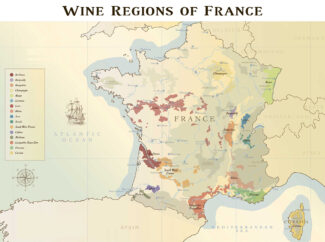
The New Frence: Neoclassicism and ‘New Wave’ Wines. (The Myth of An Immutable France.)
Terroir may be written in stone (and soil and climate) but culture is not. Although wine represents the most valuable sector of French agriculture, the attitude of the people toward it has changed rather dramatically over the past few decades. Wine consumption in France is half what it was in the 1960s; younger generation that has turned away from wine more than any other age group. In February 2023, Agriculture Minister Marc Fesneau announced plans to help the industry respond to what he described as a ‘crisis in the wine sector’, including financial aid for producers wishing to distill excess wine and supporting growers by developing longer-term plans in light of climate change challenges and evolving consumption patterns.
In the meantime, the ever-resilient old guard, refreshed with novel ideas as a new generation takes the reins, has laid the ground work for what author Jon Bonné refers to as ‘neoclassicism’—a return to the roots, where wines taste more transparently of its origin, and regions not previously regarded for quality have discovered that a host of new techniques—bolstered by warmer, drier weather—has transformed outlying appellations from blips on the radar to regions that demand our attention. And in a land where time-honored tradition is sacred, this shift in thinking is nothing short of seismic.
At Elie’s we have followed these trends with our own personal microscope, wandering the hectares, talking to the vignerons, sampling from cellars full of this new-wave of French wines. As France is not immutable, neither are we, and armed with both a love for French wine and a fascination with its expansive evolution, we will do our best to be the most comprehensive source of neoclassical French wines on this side of the Atlantic.
Climate Change Pushes Vignerons To Rethink Winemaking Practices
Freak frosts and soaring temperatures, devastating droughts and downpours, sultry winters that encourage vines to bloom before their time—these are mere symptoms of the larger condition (which may, in many cases, be called a catastrophe) known as global warming. In France, where many vineyards exist in a precarious ‘Goldilocks zone’ of grape viability, this phenomenon has forced changes in such practices as have seen winemakers through centuries.
Short of lighting up hundreds of flaming candles and using the downdraft from helicopters to protect precious young buds (as occurred across France in 2019), winemakers are clenching their hidebound teeth and replanting vineyards to previously ungrowable varieties. The Jura, for example, is producing higher-quality Pinot Noir than ever before and vintners are delving back in time to the historic varieties of the area that were abandoned decades ago. Producers are rethinking canopy management, vine trellising and pruning techniques, developing cover crops and extensive shading methods, increasing vineyard biodiversity and finding ways to reuse water during droughts.
Climate change is complicated, and even if temperature is the most influential factor in overall growth and productivity of wine grapes, there’s far more to consider: Rainfall is pivotal, and too much rain during harvest season can lead to watery grapes and a weak vintage, while humid conditions in the spring lays a welcome mat for pests, fungi and mildew. Rising sea levels play a role as well, and it is likely to get worse: According to NASA, oceans worldwide are estimated to surge at least 26 inches by 2100, and will decimate coastlines and their sway over nearby viticultural regions.
Alsace
According to many of us, the wines of Alsace are criminally under-represented on most wine lists and in most collections, but in this cool corner of northeast France is surfacing those eager to carry forward the torch. To each of them, a critical question arises: “Do I continue to make wines in the style my fathers and grandfather, or implement changes to show a different approach?”
Jean-Frédéric Hugel from Hugel in Riquewihr responds this way: “If you need proof of climate change, ask vintners; grapes and are great witnesses of it. At the beginning of his career my grandfather saw a regular harvest start on October 15th, so that’s when he brought in bring pickers to start a six-week harvest. Today we harvest in 4 to 5 weeks and start on average 15th of September and in 2018 and 2017, the 7th and 5th of September, with sugar content far higher than in later harvests of the past.”
Overall in Alsace, climate change has been a blessing, as in the past, the main challenge was ripening grapes. On average, the region once saw two unripe vintages per decade and produced wines that would have been unsellable in the current market. Now, they are rare, while the two ‘exceptional’ vintages per decade that Alsace once enjoyed has become four, and often, six.
$89 White Alsace Trio: Riesling, Gewürztraminer, Pinot Blanc
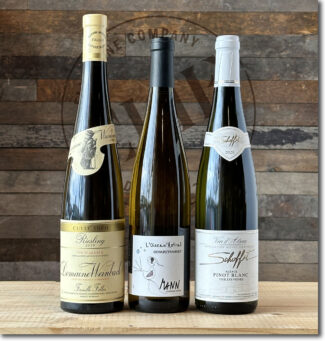
Alsace Riesling, Domaine Weinbach ‘Cuvée Théo’ 2019 white ($39)
An elegant, pure and aromatic Riesling from the Weinbach clos, made with biodynamic grapes; it offers ripe citrus on the nose, yellow peach on the palate and a salty-piquant finish with plenty of athletic acidity.
Alsace Gewürztraminer, Domaine Mann ‘L’Oiseau Astral’ 2020 white ($30)
‘The Astral Bird’ is an expressive Gewürz from Biodyvin-certified vineyards; it shows nice extracted fruit, with lychee and mangosteen in the forefront and spicy acidity that gives it remarkable length.
Alsace Pinot Blanc, Domaine Schoffit ‘Vieilles Vignes’ 2020 white ($20)
A blend of Pinot Blanc and Pinot Auxerrois, from a plot where the average vine age is fifty years. Expressive up front with musky floral tones and a succulent apple core, a wisp of sweetness, zesty acids and plenty of grip on the finish.
Burgundy
As writer Jon Bonné maintains, “It’s not that the world hasn’t always revered Burgundy, but the past two decades have been very good to this sliver of eastern France. The Côte d’Or has become the darling of wine lovers as no other place has—its popularity today is unprecedented and its best vineyards and producers are the stuff of modern legend. Fans pore over esoteric maps and data in a way that verges on fetish, and they pay dearly to celebrate with their fellow Burgundy lovers.”
Even so, at the turn of the twenty-first century, Burgundy was just beginning to recover from disastrous winemaking decisions that marked the late 1980s and early 1990s, when red Burgundies were often deeply extracted and thick and aged in too much new oak with the goal of emulating the bigger style of Pinot Noir gaining favor at the time. The whites, in contrast, had a tendency to oxidize prematurely.
These days, the requisite changes in thinking are being wrought by pioneering, educated and confident winemakers, many of whom are very young. Organics and biodynamics are understood as being the only logical choice to restore terroir (rather than marketing) as the essence of the Burgundian persona.
$142 Red & White Burgundy Trio: Givry, Mercurey, Rully
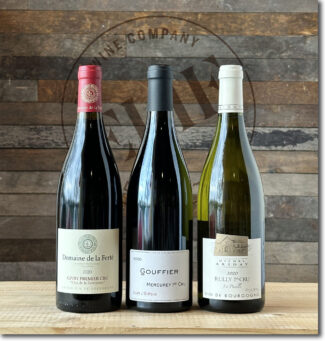
Givry, Domaine de la Ferté Premier Cru Clos de la Servoisine 2020 red ($44)
The Clos represents just under two acres of vines planted in the early 1970s in dense clay and silty soils. Natural yeast fermentation followed by aging in large foudres; the wine shows lush blackberry with an edge of dark chocolate and spice, supple tannins and a balanced finish.
Mercurey, Gouffier Premier Cru Clos l’Évêque 2020 red ($49)
Hand-harvested organically-grown grapes vinified 40% whole cluster and aged in 228 liter barrels for a year. It offers silken cherry notes, earthy forest floor, bramble berries and a lean, chalky finish.
Rully, Domaine Michel Briday Premier Cru La Pucelle 2020 white ($49)
From an acre and a quarter planted on shallow clay; this Chardonnay comes from 45-year-old vines and shows richly concentrated citrus notes, green apple, white flowers and a touch of toast and flint on the finish.
Beaujolais
‘Beaujolais Nouveau’ may stir up some unpleasant memories, but New Beaujolais—coming of age during the global climate crisis—is different sort of critter. The pitfalls are legion: “It’s easier to find a drought-resistant grape variety than it is to convince both producers and wine-loving public to drink it,” says Natasha Hughes, MW. For Beaujolais, a one-trick pony named Gamay, the experimental mix of Alsace and Rhône varieties may be a hard sell, but it forms a component of research by Sicarex—an organization working on behalf of Beaujolais to mitigate the worst excesses of climate change.
Even so, that is not how the story of modern Beaujolais will likely resolve itself. Gamay will not only survive intact, it may well become a younger generation’s substitute for the red Burgundy they cannot afford and are likewise unwilling to invest the time required for it to reach full maturity. Wines built for upfront drinkability, made without status markers like new oak, are becoming not only acceptable, but embraced as great wines. Beginning in the 1980s, a group of Beaujolais winemakers began to reconsider farming practices and cellar work, believing that ripe fruit and diligent, controlled winemaking with native yeasts could make far better Beaujolais. Their legacy is obvious today, and Beaujolais—the Crus especially, but not exclusively—are a totem of how wine itself has changed.
$125 Red Beaujolais Trio: Morgon, Fleurie, Moulin-à-Vent
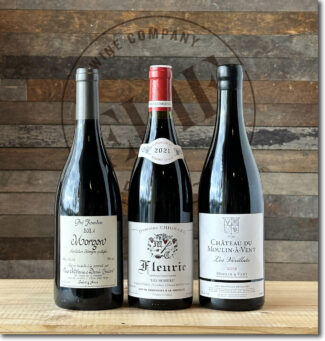
Morgon, Mélanie et Daniel Bouland ‘Pré Jourdan’ 2021 red ($39)
Ample and fleshy, the wine displays a rich nose of raspberries, cherries and sweet spices, with espresso, wood smoke and ripe tannins in the mid-palate.
Fleurie, Domaine Chignard ‘Les Morier’ 2021 red ($29)
‘Les Morier’ is an exceptional vineyard, steep and stony with a granite core, and a portion of it reaches into Moulin-à-Vent—an appellation known for its structural depth and Rhône-like aromatics. True to form, the wine is velvety and fleshy, showing mulberry and cherry preserves over a focused, elegant nucleus.
Moulin-à-Vent, Château du Moulin-à-Vent ‘’Les Vérillats’ 2019 red ($57)
At 1000 feet, Les Vérillats perches atop the hill, even above the famous windmill, where a thin layer of sand covers pink granite. 45-year-old vines give the wine enviable depth and structure to support notes of mature red and black fruit, hints of spice and a persistent floral river of rose, peony and violet.
The Loire
The Loire, from Muscadet to Sancerre, is another French wine region that is changing so rapidly that it is difficult to keep up. The natural wine movement finds its unofficial headquarters here, and if the gorgeous châteaux and picturesque chalky-limestone villages speak to the past, the winemakers have their sights set on the future. Whereas the Loire’s white wines have long held a reputation for their remarkable depth, particularly among white Burgundy lovers seeking an affordable substitute, and the reds, generally made from Cabernet Franc, have legions of Bordeaux fans, they are increasingly seen as something more than an alternative wine. They have established a modern reputation of being soulfully complex and savory, remarkably expressive of their individual terroirs.
“In the 1980s, the wines were known for being easy and simple,” says Matthieu Vallée of Château Yvonne, one of Loire’s up-and-coming talents. “Now it’s finally changed, and people can see a different side.”
$97 White Loire Trio: Muscadet Sèvre-et-Maine, Sancerre, Montlouis-sur-Loire
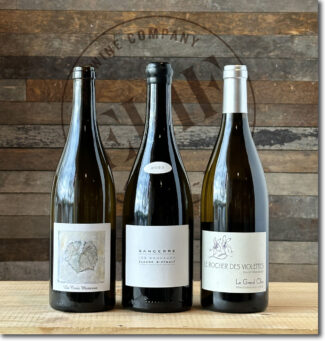
Muscadet Sèvre-et-Maine, Complemen’ Terre ‘La Croix Moriceau’ 2021 Natural white ($29)
The Melon de Bourgogne grapes are manually harvested and stainless steel tanks are used for débourbage before racking into smaller concrete vats for fermentation and elevage for 7-8 months. The wine then undergoes malolactic fermentation, and minimal sulfur is added at bottling. The wine is racy and tight, with macerated apple notes and a slight, pleasant oxidation and on the finish to accompany crushed stone, salinity and a whiff of campfire.
Sancerre, Domaine Claude Riffault ‘Les Boucauds’ 2022 white ($36)
The Sauvignon Blanc grapes are grown in the deep clay of Les Boucauds lieu-dit, which lends fullness to the fruit and produces a tropical profile with melon, pear and pineapple alongside white flowers.
Montlouis-sur-Loire Sec, Le Rocher des Violettes “Le Grand Clos” 2020 white ($32)
The Chenin Blanc grapes originate in three lieux-dits in Mont-Louis, Les Borderies, Le Grand Clos and Bel Air. These are the oldest vines of the estate (90+ years old) and are subjected to high density plantings on south facing slopes where the terroir is clay and silex above pure chalk. The wine shivers with crystalline acidity and shows flecks of richness amid white flowers, ripe lemons and subtle honeyed notes.
Bordeaux
Dollar for dollar, Bordeaux produces more wine than anywhere else in France; its marketing power, reputation and history have impelled it to a pinnacle in the imagination of most of us. Still, the perch is precarious, in part because it has largely been built around the 1855 classification system that ranks its top properties. And nearly everyone not atop that pyramid views it as past its expiration date.
Of Bordeaux’s 8,500 properties, only about 120 benefit from this hierarchy, and if ever a wine region was screaming for an updated perspective, it’s Bordeaux.
Even the hidebound Conseil Interprofessionnel du Vin de Bordeaux (the Bordeaux Wine Council, formed in 1948) seems on board. Six new grapes join Bordeaux’s previously approved varieties in an effort to adapt to climate change, and the area home to a growing number of producers making eminently drinkable wine at artisan scale, while avoiding the style wars that have fueled the region’s woes.
As can be seen elsewhere in France, biodynamics and biodiversity, and often, lighter extractions closer to the classic ‘claret’ style, is a stand against the hive mind in Bordeaux. This is being driven by vignerons rather than public relations firms, people who believe in human-scale Bordeaux and who farm with an eye toward organics and who revere the freshness and integrity that has made the region so beloved.
$124 Red Bordeaux Trio: Saint-Estèphe, Saint-Émilion, Pessac-Léognan
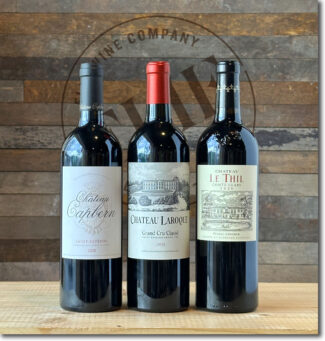
Saint-Estèphe, Château Capbern 2020 red ($38)
A Cabernet Sauvignon-dominated blend that includes 37% Merlot and 1% Petit Verdot, all of which was brought up in 60% new barrels, resulting in a deep, dark, earthy, classic Saint-Estèphe with cassis and blueberry as well as ample chocolate, damp earth and leafy herb-like aromas and flavors.
Saint-Émilion, Château Laroque Grand Cru Classé 2018 red ($44)
97% Merlot and 3% Cabernet Franc from one of the highest sites in the appellation. The wine shows flamboyant notes of stewed plums, Black Forest cake and boysenberries plus hints of candied violets, star anise and tobacco leaf with a waft of sassafras.
Pessac-Léognan, Château le Thil Comte Clary 2020 red ($42)
Blackberries, currants and hints of hazelnut form the framework of a sensuous and lithe wine with multiple spice nuances—cloves, ginger and soft mint.
The South-West
Nowhere in France is the notion that ancient grapes do best in their native soils more pronounced than in the southwest; critics and rule makers be damned. Some of these grapes grew wild, while others found places where they thrived after Roman soldiers and medieval troubadours carried them through hills and valleys. Though the cast is enormous, many of these vines are not found elsewhere and are varieties with which many of us are only peripherally familiar: grainy Négrette, small-berried Petit Manseng, local Tannat whose name, it is assumed, derives from its mouth-puckering tannin content. Some are grapes that have all but disappeared, but are now being revived by growers who revel in the homegrown DNA and are modernizing tradition rather than breaking with it.
Having at one time receded into the role of humble country wine, a new generation of vignerons in the southwest are beginning to produce remarkable, avant-garde wines. Natural-minded, new-wave winemakers are appearing on the scene with increasing regularity. They seem to have a deep appreciation for the nuance and depth of southern traditions, maintaining its bounty of local grapes and eager to connect best of the countryside’s past to the future. They are quiet heroes and quality-focused pioneers demanding change from the twentieth-century norm and the Southwest’s blandly commercial path.
$101 Red & White South-West Trio: Cahors, Côtes-de-Bergerac, Bergerac
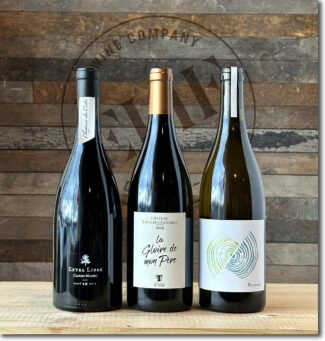
Cahors, Château du Cèdre “Extra Libre” Natural 2019 red ($31)
The winery eliminated the use of chemicals in 1992, emphasizing sustainable practices and minimal intervention in the vineyards—this blend is 90% Malbec, 5% Merlot and 5% Tannat, hand-harvested from vines between 15 and 30 years of age, fermented in concrete tanks, then aged 12 months in large, used barrels. The wine shows vibrant acidity, to brace its dark fruit, cocoa and very fine tannins.
Côtes-de-Bergerac, Château Tours des Gendres ‘La Gloire de Mon Père’ 2018 red ($31)
A blend of 53% Merlot, 35% Cabernet Sauvignon and 12% Cabernet Franc that spends 12 months in oak and six months in bottle before release. A smooth and creamy palate juicy with concentrated blackberry and cherry notes, a hint of smoke and a long, mineral-driven finish.
VdF Bergerac, Combrillac ‘Petchalba’ 2021 white ($39)
An interesting and unusual blend: 50% Sauvignon Blanc, 40% Sémillon and 10% direct-pressed Cabernet Sauvignon. Named for a Macedonian rite of passage, the wine is aged in a mix of Italian sandstone amphorae and used barrels and bottled without fining or filtering.
Jura
‘Voile’ is a term that most wine people associate with the Jura’s late-harvested Vin Jaune—a thin veil of yeast that floats atop the vat to toughen and mature the must, exposing it to limited amounts of oxygen. But in the Jura, it is used not only in their famed, sherry-like ‘yellow wine’, but in many others based on the local Savagnin variety.
It’s an interesting method, not to everyone’s tastes, and perhaps a problem as modern wine drinkers look more and more to terroir and less to technique. But the switch is not far-fetched in Jura, whose soil is somewhat similar to its grand neighbor to the west, Burgundy (both sit on an ancient seabed) and limestone and clay in varying configurations that can accommodate Chardonnay as well as Savagnin. Ironically, in Jura, the radical reinvention is to go more mainstream—Jura’s conventional winemaking is unconventional in the rest of France, and a growing number of winemakers believe that it blurs the region’s true potential.
“With the traditional style, all the wine was looking similar after oxidation with the veil,” says Julien Labet, one of the champions of the new style, called ‘ouillé.’ “They all had that nutty taste, and didn’t have the personality they had before the veil.”
Resistance has been marked, largely because the Jura enjoys its reputation as an outsider and frowns on any changes designed to erase its uniqueness. Still, there is little chance that the appellation will ever become ‘like everybody else.’ Chardonnay planted to densely spaced, head-trained on the Jura’s terroir yields wine that are more savory and saline than their Burgundian cousins, their fruit and flavors a bit more generous.
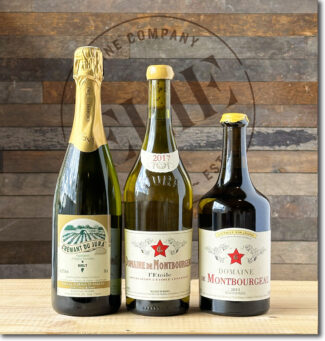
Crémant-du-Jura Brut, Domaine Overnoy-Crinquand ($33)
100% Chardonnay with 30 months of lees contact and a mere 0.5 grams per liter dosage. A non-vintage wine but produced exclusively from a single vintage, it offers textural plushness and breadth balanced by iron-tinged minerality and a gently honeyed character.
L’Étoile, Domaine de Montbourgeau 2017 white ($30)
95% Chardonnay with Savagnin topping off the blend, this wine originates on the southeastern slopes of L’Étoile, where vines average 40 years. Following malolactic fermentation, it spends up to three years in neutral oak, giving it what may be considered a ‘typical’ Jura profile for Chardonnay, tasting slightly oxidized, although not nearly in the style referred to locally as ‘sous voile’, or ‘under veil’—referring to the yeasty flor that characterizes Vin Jaune. About 20,000 bottles are produced: It is the winery’s mainstay.
L’Étoile, Domaine de Montbourgeau 2011 ‘Vin Jaune’ ($89)
Befitting the style, this Vin Jaune is 100% Savagnin grown on blue marl rich in limestone. The wine spends one year in small, neutral oak casks followed by six years in larger hogsheads, allowing for the longer, requisite maturation period. The wine displays quince jam notes sheathed in warm, yeasty lemon curd and resonant acidity. Around 3000 bottles made.
Savoie
Metaphors linking wine to its place of origin are the stuff of poetry, but they’re also the foundation of terroir. Among the most common descriptors of the area’s high-altitude wine is ‘refreshing’ which is an offhand way of saying that it tends to be lower in alcohol and higher in acidity than valley wines. These acids are often the end result of the cool mountain air which they resemble, giving distinct, cleansing mineral characteristics to the wine with citrus and herbs rather than jammy fruit. Alpine wines have a crunchy sizzle and a cool sappiness unlike wine from anywhere else. Not only that, but the predominant grapes don’t show up on many other radars, so the unique textures commingle with a whole new flavor profile to surprise and delight the palate.
Over the past twenty years, a new wave of independent vignerons has been boosted by organizations dedicated to preserving these singular grape varieties, and Savoie has finally begun to come into its own. Natural wine is increasingly becoming the order of the day—elevations are such that the mildew that affects vines at sea level is not an issue, and like wines from the Jura were a decade ago, Savoie wines are still considered somewhat geeky and under-the-radar—which makes it an ideal region for innovative winemakers from a younger generation to make their mark.
$114 Red & White Savoie Trio: Savoie, Savoie-Arbin, Roussette-de-Savoie
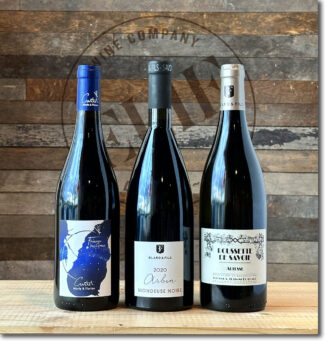
Vin de Savoie, Domaine Marie & Florian Curtet ‘Frisson des Cimes’ Natural 2019 red ($45)
An interesting blend of organically-farmed Mondeuse, Gamay and Pinot Noir planted in sandstone with a southwestern exposure. It is made with whole cluster fermentation and without pump overs, which lasts around a month before pressing. This is a dark, pungently earthy wine with notes of mulched forest floor, black plum, blueberries, pine, Kalamata olives and roasted meat.
Vin de Savoie Arbin, Blard & Fils ‘Mondeuse Noire’ 2020 red ($39)
Mondeuse is a local variety often described as a cross between Pinot Noir and Gamay with a touch more tannin. This offering is grown in clay and limestone soils and there is a pronounced iron-rich mineral note on the nose along with red fruit and lacy mouthfeel.
Roussette de Savoie, Blard & Fils ‘Altesse’ 2020 white ($30)
Made from 100% Altesse grown on Mont Granier scree—a mix of clay and limestone with a bit of marl and silex. 80% of the grapes are direct-pressed while 20% are destemmed and macerated on the skins for 10 days. The wine is wild yeast fermented and aged on the skins in stainless steel tanks for 10 months and bottled without filtering or fining. A nice backbone of acidity sets off notes of bergamot, honey and hazelnut, mountain herbs. As an aside, the traditional pairing for Roussette de Savoie is Raclette and its typical sides of boiled small potatoes, charcuterie, and apricot mustard.
The Rhône: North
Fifty years ago, both Côte-Rôtie and Cornas along with much of the northern Rhône, were struggling just to survive. Around 1966, when the appellation had fallen into obscurity, its overseers simultaneously decided to revive quality, but also to expand to the flatlands above its rocky granite and schist terraces. The appellation’s traditional method of farming steeply-sloping vines by hand made for pretty images, but were a curse financially. The expansion ended a traditional style of Côte-Rôtie that had been fresher, even a bit light, and more overtly spicy than fruity.
By the 1990s, the most popular wines of Northern Rhône were thick and heady, made with carefully controlled fermentations, heavy extractions and plenty of new oak. As the climate warms, the conditions that produce big, high-alcohol wines are becoming the rule of the day. Not only that, but rising temperatures parallel the rising cost of vineyard acres, and many properties are being snapped up by wealthy overseas investors who care more for market appeal than subtle winemaking.
But a number of smaller, previously dormant areas that nestle in pockets near the big-name appellations in the Rhône have begun a remarkable comeback; this is the result of hard work by few steadfast vignerons who have saved noteworthy properties from being reclaimed by forest. It is among these parcels of land, which peek through mostly unfriendly hinterland that we make our modern-day discoveries— worthy and exciting Syrahs; the best made since the phylloxera blight wiped out the original vineyards in the 1800s.
$124 Red Northern Rhône Trio: Côte-Rôtie, Crozes-Hermitage, Saint-Joseph
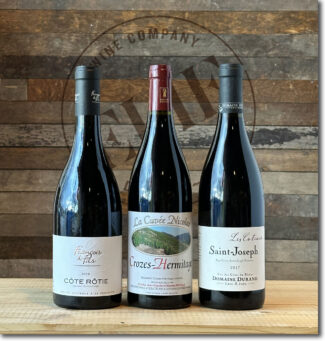
Côte-Rôtie, François & Fils 2019 red ($67)
Classic Côte-Rôtie notes of violets and crushed blueberries bathed in silky ripe tannins. A traditional co-ferment with 4% Viognier that offers a floral lift and a touch of nutmeg in the finish.
Crozes-Hermitage, Domaine Jean-Claude et Nicolas Fayolle ‘La Cuvée Nicolas’ 2020 red ($25)
100% Syrah from youngish vines grown in Gervans, a small granitic outpost within CrozesHermitage. Full-bodied without being heavy, ripe without being jammy, the wine is juicy with brambly wild berries, licorice and creamy mocha tones.
Saint-Joseph, Domaine Éric et Joël Durand ‘Les Coteaux’ 2017 red ($32)
Big-shouldered, yet velvety, concentrated and rich, the wine shows cherry and plum pudding infused with anise and accented by warm fruitcake spices.
The Rhône: South
2021 is an example of the sort of challenging vintage the producers in Southern Rhône are facing; a wet winter was followed by an unseasonably hot spring, followed by an extensive frost in April that drastically reduced yields. In November these climatic extremes reduced overall French wine production by 27 % and the vintage proved to be one of French wine’s most difficult years on record.
But the effects of climate change are hardly restricted to a single season. In recent years, each individual vintage has presented its own unique set of trials, an inevitable offshoot of rising temperatures, which on average have increased 1.5°C; predictions are that things will get worse. Of course, it’s not limited to France, but the delicacy of the vineyard ecosystem is Southern France is being battered by heat waves, drought and fires, there are also spring frosts, hail, and excessive rain with damage wrought by one or more in any given year.
As the world is eager for Rhône wine and winemakers understand they must be willing to provide enough of it, they look for a silver lining, even if it means rethinking France’s longtime wine regulations. As relatively new appellations like the villages of Gigondas and Vacqueyras gaining fame, attention has turned to other, as-yet-unexploited areas where climate change may be a blessing in disguise. Historically, elevation has not been a defining characteristic of the region, as the vast expanses of the Côtes du Rhône to Cru appellations like Châteauneuf-du-Pape, Gigondas and Vacqueyras, the vineland is characterized by rocky flatlands where ample sunlight pumps richness into the wines.
According to Christian Voeux, owner and winemaker of Domaine de l’Amauve, located just north of Gigondas, “In the past, altitude was not considered an advantage for winegrowers in Southern Rhône. High altitudes would delay the maturity of grapes, and when full maturity was finally reached at the end of September or October, heavy rains would come, affecting the quality of grapes.”
Over the last two decades, climate change has rewritten the rule book. Throughout the Southern Rhône, a steady annual increase in temperature has expanded the possibilities for viticulture into a diversity of hillside terroirs rimming the valley, while those on the ground level may suffer the fate of most grapes pushed extreme ripeness in shorter ripening cycles, yielding blowsier wines with lower acidity levels.
$137 Red Southern Rhône Trio: Châteauneuf-du-Pape, Gigondas, Lirac
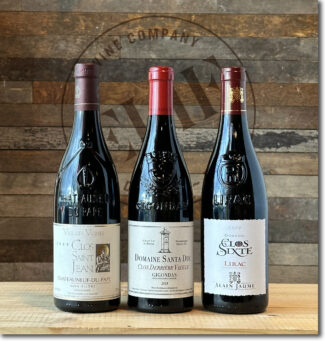
Châteauneuf-du-Pape, Clos Saint Jean ‘Vieilles Vignes’ 2019 red ($58)
A blend of old vine Grenache, Syrah, Mourvèdre, Cinsault, Vaccarèse and Muscardin located in and around lieu-dit Le Crau. The Grenache is aged in concrete for 12 months while the remainder is aged in demi-muid. The fruit is reminiscent of warmed plum sauce and blackberry purée, while the savory side shows up as garrigue, earth and toasted spice.
Gigondas, Domaine Santa Duc ‘Clos Derrière Vieille’ 2018 red ($57)
Produced from old vines in limestone-rich soil, the blend is predominantly Grenache shored up with Syrah and Mourvèdre. Classic Gigondas terroir appears as ripe blueberry and strawberry mingled with black pepper, fresh green herbs, earth, resin and anise.
Lirac, Domaine du Clos de Sixte Lirac 2019 red ($22)
50% Grenache, 35% Syrah and 15% Mourvèdre grown organically under Ecocert. The vineyard soil is mostly limestone, alluvial soils with quartz, sand and rock. Fermentation takes place in stainless steel with hand-sorted, crushed and destemmed grapes.18 days of vatting with pigéage is followed by 16 months in concrete vats and 30% new French oak barrels. The bouquet shows blackcurrant liqueur and pie spice, the palate is full, harmonious and elegant with licorice and vanilla on the finish.
Provence
Once known primarily for somewhat generic pink wine, Provence is—like the rest of France—in the middle of self-examination. It’s true that they are ‘redefining’ game somewhat later than most appellation, primarily because in the words of winemaker Henri Milan (Domaine Milan). “We live in a parallel universe here, entranced by our own charmed lives and abandoning any thought of the world beyond.”
Those lives, beyond the famous rosés, also include Bandol’s Mourvèdre, Cassis’ Clairette, and various permutation of the ancient grape Tibouren. But a handful of pioneers, exploring the back country and delving deeply into the soil, have begun to work with old vine Grenache and Cinsault while discovering that little-known and colder subsets of Provence have warmed to a level where the full diversity of southern grapes can be planted successfully and produce wine without the characteristic heat and high alcohol and retain the essential freshness that discerning palates appreciate.
$137 Red & Rosé Provence Trio: Bandol, Les Baux-de-Provence, Côtes-de-Provence
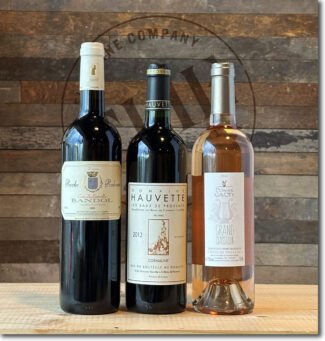
Bandol, Domaine Roche Redonne ‘Cuvée Les Bartavelles’ 2019 red ($69)
95% Mourvèdre and 5% Grenache; the wine’s cuvée name honors the local rock partridges. The vines average 40 years old; the youngest are 20 years and the oldest, 60. The yields are very low and the steep-hilled vineyards can only be harvested by hand. The wine shows boysenberry, blackcurrant, pepper and graphite shored up with well-integrated tannin.
Les Baux de Provence, Domaine Hauvette ‘Cornaline’ 2012 red ($41)
Cuvée Cornaline is a plush blend of 50% Grenache, 30% Syrah and 20% Cabernet Sauvignon farmed biodynamically on cretaceous limestone terroir. Grenache brings fresh strawberry and thyme to the profile, Syrah, black pepper and olive while Cabernet Sauvignon gives its black currant, tobacco and a light, enjoyable smokiness.
Côtes-de-Provence, Domaine Gavoty ‘Grand Classique’ 2022 rosé ($27)
Made of Grenache and Cinsault in roughly equal proportions. Rather than being pressed immediately after harvest as many Provence rosés are, Grand Classique macerates for several hours before pressing, and the saignée and first-press juice are vinified separately. The resulting wine shows strawberry and watermelon electrified by racy acidity.
The Languedoc
The Mediterranean Sea takes a sizeable chunk out of France’s hindquarters, and the bite-shaped crescent contains a few of the most dynamic winegrowing regions in the country. Clockwise, from just north of Spain, Languedoc is a swarthy appellation known for Grenache and Carignan blends—two varieties that love the hot coastal sunshine. Often joined at the hip with neighboring Roussillon, the insanely productive AOP accounts for more than a third of the country’s wine output. Historically, this wine was copious, inexpensive and rather forgettable—everyday wine for the tables of ordinary people. Since the mid-twentieth century, however, with the advent of irrigation in the foothills and coastal plains of Southern France coupled with improved techniques, the region now boasts fewer vines that produce wines of increasing quality.
A jigsaw of soils and a broad swath of microclimates creates ideal terroir for the warm-weather, full-bodied varietals often associated with the Rhône, while sharp diurnal shifts allow for the preservation of aroma and natural acidity, resulting in wines of extraordinary balance. A further plus is that Languedoc-Roussillon’s hot, dry climate discourages the growth of mildew and fungi, making synthetic pesticides and herbicides less necessary. As such, it has become a proving ground for organic and biodynamic producers.
$119 Red Languedoc Trio: Faugères, Terrasses-du-Larzac, Languedoc-Hérault
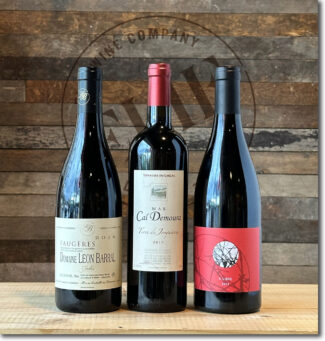
Faugères, Domaine Léon Barral ‘Jadis’ 2016 red ($47)
‘Jadis’ roughly translates as ‘long ago’ or ‘in olden days’—a wistful glance at the traditional way of doing things. Old vine Carignan and Syrah from the domain’s southern-facing vineyards, the wine offers exotic layers of musk, sour cherries and herbs with a mineral and saline finish.
Terrasses-du-Larzac, Mas Cal Demoura ‘Terre de Jonquières’ 2017 red ($32)
30% Syrah, 25% Carignan, 20% Cinsault, 15% Mourvèdre and 10% Grenache, with each variety vinified separately. The initial fermentation occurs in temperature-controlled stainless steel vats, after which the wines are racked into barrels and, after one year of aging, blended. The wine is given an extra six months of aging before being bottled without fining or filtration. The wine offers black fruit, licorice, and garrigue and remains elegant and fresh on the palate.
VdF Languedoc-Hérault, Clos de la Barthassade ‘K Libre – Carignan’ 2019 red ($40)
50% whole cluster Carignan and 24 months élevage in demi-muid and concrete egg produces a wine with an amazing array of spices on the nose; potpourri, Asian spices and sandalwood with a bright mineral overtone and a touch of smokiness. The palate is driven by fruit, especially raspberry.
The Roussillon
Author Jon Bonné refers to the sweet, fortified, Grenache-based wines of Banyuls as ‘Port that isn’t trying too hard.’ Likewise the Muscat-based wines of Rivesaltes, just to the north, whose fully oxidized, dry wines native come across like France’s response to Sherry.
But the real interest in today’s world is dry, intensely mineral red and white wines being made there these days; a factor that may be confused when Roussillon’s best dry wines are lumped in with Languedoc to the north, doing a disservice to both appellations. Roussillon’s current focus is clear: Acid-driven wines that are unquestionably southern, but also subtle, as winemakers have found a way to modulate the sun. In part this involves impeccable, often organic farming to make wines whose complexity rivals top Rhônes.
Roussillon’s affordable land also makes it a magnet for a lot of natural-wine pioneers including naturalist icons like Edouard Laffitte of Le Bout du Monde, whose easygoing wines mirror those of several like-minded vignerons and prompted their village of Lansac to be dubbed Jajakistan—an in-joke derived from French slang for gluggable wine.
$104 Red Roussillon Trio: Collioure, Maury, Corbières
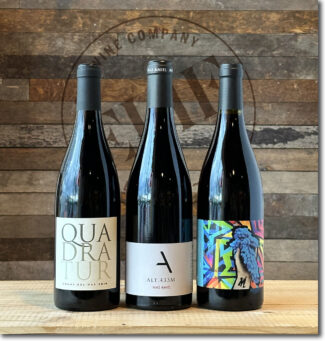
Collioure, Coume del Mas ‘Quadratur’ 2016 red ($37)
50% Grenache Noir, 30% Mourvèdre and 20% Carignan from high-altitude old vines with concentrated, low yield fruit. In the winery, strict hand and table sorting precedes a long maceration and fermentation intended to extract maximum flavor, followed by 12-14 months in oak barrels before bottling without filtration. The wine showcases delicious notes of dark fruits, spices, wild herbs and earth.
Maury, Mas Amiel ‘Alt.433m’ 2017 red ($36)
The plot for this wine was planted in 1962 with Grenache and Lladoner Pelut vines at an altitude of 433 meters—hence, the name. Lladoner Pelut is a natural mutation of Grenache which reaches phenolic ripeness sooner and produces wines with a lower alcohol content; it is more commonly used in the wines of Priorat, Catalunya. It offers delicate notes of crushed stone, cranberries and fresh herbs in a silky package with hints of orange zest and rose hips.
VdF Roussillon-Corbières, Domaine Yohann Moreno ‘GS’ 2021 red ($31)
A fun, ‘glou-glou’ style of light Grenache and Syrah; a crunchy core of candied blueberry is offset by a bit of minerality.
Corsica
Corsica has been described as penumbral Italy and Sardinia’s French twin, although in fact, it is very much a wine-producing appellation with its own native soul. Corsicans are imbued with a vehement sense of pride and independence, born in part from perpetual watchfulness: As winemaker Christian Giacometti shares, “The reason our villages were never near the sea is that the Corsicans were always fending off invaders.”
Corsican vignerons work with a roster of seemingly unpronounceable varieties like Sciaccarellu, Biancone and Paga Debiti. In the past couple of decades, these sumptuous, spicy wines have found a growing patronage among those of us in the west eager to learn more about a peripheral Mediterranean gem and these island wines, created without France’s intellectualism or Italy’s numbing regulations and crowd-pleasing varieties, opting instead for face-value frankness and above all, native grapes.
$117 Red & White Corsica Trio: Patrimonio, Corse Figari
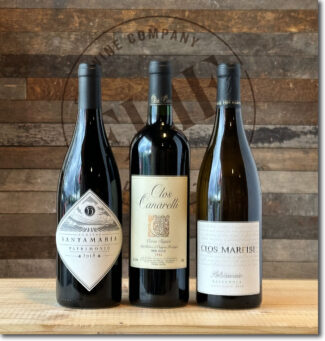
Patrimonio, Domaine Santamaria 2018 red ($37)
100% Nielluciu from 25-year-old biodynamic vines grown in a microclimate meliorated by the Ligurian Sea, where soils are (unlike much of Corsica) largely composed of chalky clays and limestone. The grapes are hand-picked and fermented on native yeast, then bottled without fining. Patrimonio is the first AOP in France to forbid chemical weeding; the wine shows cranberry and raspberry with a touch of earthy minerality and spice.
Corse Figari, Clos Canarelli 2016 red ($45)
The soils of the Figari AOP make up France’s southernmost wine region, and it is maintained by many that this bottling represents the best profile of the Sciaccarellu grape to be found. The bright sunshine and granite soils of the southwest part of the island are a perfect cradle for the grape and the wine shows it’s characteristic herbal spice behind soft berry notes and easy tannins.
Patrimonio, Clos Marfisi ‘Ravagnola’ 2020 white ($35)
Vermentino (known in Corsica as Vermentinu) shows off its island expression as floral, with bright flashes of citrus and an almost salty finish, quite reflective of the clay, chalk and schist soils less than a mile from the sea.
A Gift That Keeps On Giving
Membership To ‘The Champagne Society’
Bimonthly Subscription
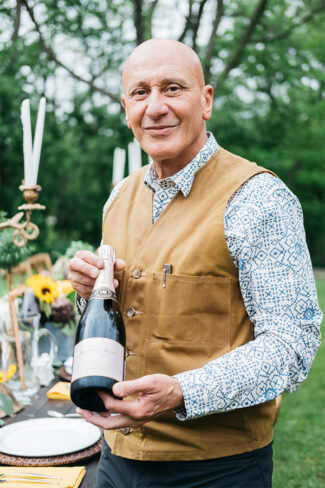 Not only is Champagne the quintessential drink of celebration, it has traditionally been a gift given with ramped-up sentiments. This year we are offering a couple of variations on this theme, beginning with an opportunity to gift a special someone a six-month or twelve-month membership to The Champagne Society. Our pick for December will be packaged in a wrap-ready gift box along with a congratulatory certificate explaining what lies ahead in bi-monthly installments. For more information please visit our website page: A Holiday Gift: ‘The Champagne Society’ Membership 6-Month ($299) or 12-Month ($589) Subscription.
Not only is Champagne the quintessential drink of celebration, it has traditionally been a gift given with ramped-up sentiments. This year we are offering a couple of variations on this theme, beginning with an opportunity to gift a special someone a six-month or twelve-month membership to The Champagne Society. Our pick for December will be packaged in a wrap-ready gift box along with a congratulatory certificate explaining what lies ahead in bi-monthly installments. For more information please visit our website page: A Holiday Gift: ‘The Champagne Society’ Membership 6-Month ($299) or 12-Month ($589) Subscription.
Elie
- - -
Posted on 2023.12.15 in France, Wine-Aid Packages
Featured Wines
- Notebook: A’Boudt Town
- Saturday Sips Wines
- Saturday Sips Review Club
- The Champagne Society
- Wine-Aid Packages
Wine Regions
Grape Varieties
Aglianico, Albarino, Albarín Tinto, Albillo, Alicante Bouschet, Aligote, Altesse, Arbanne, Auxerrois, Barbarossa, Beaune, Biancu Gentile, Bonarda, bourboulenc, Cabernet Sauvignon, Caladoc, Calvi, Carcajolu-Neru, Carignan, Chablis, Chenin Blanc, Cinsault, Clairette, Cortese, Corvinone, Cot, Counoise, Dolcetto, Erbamat, Fiano, Frappato, Fumin, Gamay, Garganega, Garnacha Tintorera, Godello, Graciano, Grenache, Grenache Blanc, Grolleau, Groppello, Jacquère, Juan Garcia, Lladoner Pelut, Macabeo, Maconnais, Malbec, Malvasia, Malvasia Nera, Marcelan, Marsanne, Marselan, Marzemino, Melon de Bourgogne, Mencía, Merlot, Montepulciano, Montònega, Moscatell, Mourv, Mourvèdre, Muscadelle, Muscat, Natural, Nebbiolo, Nero d'Avola, Niellucciu, Patrimonio, Pecorino, Pedro Ximénez, Persan, Petit Meslier, Pineau d'Aunis, Pinot Auxerrois, Pinot Blanc, Pinot Gris, Pinot Meunier, Pinot Noir, Pouilly Fuisse, Pouilly Loche, Poulsard, Riesling, Rousanne, Sagrantino, Sangiovese, Sciacarellu, Semillon, Souson, Sumoll, Tempranillo, Teroldego, Timorasso, Trebbiano Valtenesi, Treixadura, Trousseau, Ugni Blanc, Vermentino, Viognier, Viura, Xarel-loWines & Events by Date
- May 2024
- April 2024
- March 2024
- February 2024
- January 2024
- December 2023
- November 2023
- October 2023
- September 2023
- August 2023
- July 2023
- June 2023
- May 2023
- April 2023
- March 2023
- February 2023
- January 2023
- December 2022
- November 2022
- October 2022
- September 2022
- August 2022
- July 2022
- June 2022
- May 2022
- April 2022
- March 2022
- February 2022
- January 2022
- December 2021
- November 2021
- October 2021
- September 2021
- August 2021
- July 2021
- June 2021
- May 2021
- April 2021
- March 2021
- February 2021
- January 2021
- December 2020
- November 2020
- October 2020
- September 2020
- August 2020
- July 2020
- June 2020
- May 2020
- April 2020
- March 2020
- February 2020
- January 2020
- December 2019
- November 2019
- October 2019
- September 2019
- August 2019
- July 2019
- June 2019
- May 2019
- April 2019
- March 2019
- February 2019
- January 2019
- December 2018
- November 2018
- October 2018
- September 2018
- August 2018
- July 2018
- June 2018
- May 2018
- April 2018
- March 2018
- February 2018
- January 2018
- December 2017
- November 2017
- October 2017
- September 2017
- August 2017
- July 2017
- June 2017
- May 2017
- April 2017
- March 2017
- February 2017
- January 2017
- December 2016
- November 2016
- October 2016
- September 2016
- August 2016
- July 2016
- June 2016
- May 2016
- April 2016
- March 2016
- February 2016
- January 2016
- December 2015
- November 2015
- October 2015
- September 2015
- August 2015
- July 2015
- June 2015
- May 2015
- April 2015
- March 2015
- February 2015
- January 2015
- December 2014
- November 2014
- October 2014
- September 2014
- August 2014
- July 2014
- June 2014
- April 2014
- March 2014
- February 2014
- January 2014
- December 2013
- November 2013
- October 2013
- September 2013
- August 2013
- July 2013
- June 2013
- May 2013
- April 2013
- March 2013
- February 2013
- January 2013
- December 2012
- November 2012
- October 2012
- February 2004
Search



